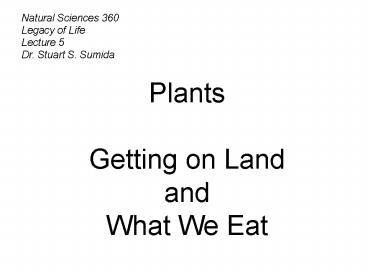NatSci360 Plants - PowerPoint PPT Presentation
Title:
NatSci360 Plants
Description:
From Late Devonian (dominant and common in Late Devonian and Carboniferous) Equisetum arvense ... Known since Late Carboniferous. Coniferophyta ('evergreens' or ' ... – PowerPoint PPT presentation
Number of Views:48
Avg rating:3.0/5.0
Title: NatSci360 Plants
1
Natural Sciences 360 Legacy of Life Lecture 5 Dr.
Stuart S. Sumida
Plants Getting on Land and What We Eat
2
(In this course, a KEY INNOVATION is a feature
that is not only a synapomorphy of a group, but
also a feature that allows or facilitates a broad
adaptive radiation.)
3
- THREE GREAT KINGDOMS OF MEGAEUKARYOTIC
PHOTOAUTOTROPHS - RED SEAWEEDS (ALGAE)
- BROWN SEAWEEDS (ALGAE)
- PLANTAE
4
OUR FOCUS ON PLANTS The Water to Land
Transition Flowering Plants
5
- The Water to Land Transition
- (How do you keep from drying out and falling
over?) - Cell Walls
- Cuticle waxy layer on aerial surfaces
- Stomata (singular stomate) openings that can
be controlled to prevent water loss - Development of Embryos
- Spores for dispersal
- Plus TWO KEY INNOVATIONS
6
KEY INNOVATIONS OF LAND PLANTS Alternation of
generations Vascular Tissues
7
- The Water to Land Transition
- (How do you keep from drying out and falling
over?) - Cell Walls
- Cuticle waxy layer on aerial surfaces
- Stomata (singular stomate) openings that can
be controlled to prevent water loss - Development of Embryos
- Spores for dispersal
- Plus TWO KEY INNOVATIONS
8
KEY INNOVATIONS OF LAND PLANTS Alternation of
generations Vascular Tissues
9
Cell Walls
10
(No Transcript)
11
Closed stomate
Guard Cells
12
Closed Stomate
Open Stomate
13
(No Transcript)
14
Alternation of Generations An alternation
between form that makes gametes (sperm and eggs)
called the GAMETOPHYTE GENERATION. And The form
that makes the spores for distribution called the
SPOROPHYTE GENERATION.
15
VASCULAR TISSUE Tissues for transporting water
XYLEM transporting food (sugars, etc.)
PHLOEM
16
Vascular Plants Tracheophyta Sphenophyta
(Horsetails) Pterophyta (Ferns) Gymnosperms Cyc
adophyta Ginkophyta Coniferophyta Anthophyta
(includes flowering plants)
17
Equisetum arvense
Sphenophyta (Horsetails and their relatives) From
Late Devonian (dominant and common in Late
Devonian and Carboniferous)
18
Adiantum
Pterophyta (ferns) Known since the Carboniferous
19
Cycadophyta (cycads) Cycas Known from
Carboniferous
20
5 million year old Ginko leaf fossil
Ginkophyta Known from end of Cretaceous (end of
age of dinoaurs)
21
Coniferophyta (evergreens or conifers) Known
since Late Carboniferous
22
Pinus aristata
Coniferophyta (evergreens or conifers) Known
since Late Carboniferous
23
Anthophyta (includes flowering plants) Some types
known since Jurassic, but flowering plants known
from end of Cretaceous
24
Flowering Plants Monocots Grasses and
others Dicots Flowers that give fruits
25
The MONOCOTS comprise one-quarter of all
flowering plant species. They include lilies,
orchids, agaves, palms, and grasses.
26
Flowering Plants So just what ARE you eating?
27
Flowering plants produce not only seeds, but
fruits. So what exactly is a fruit? Or a
vegetable for that matter? To understand, we
have to turn to flowers and flower structure
28
(No Transcript)
29
(No Transcript)
30
(No Transcript)































